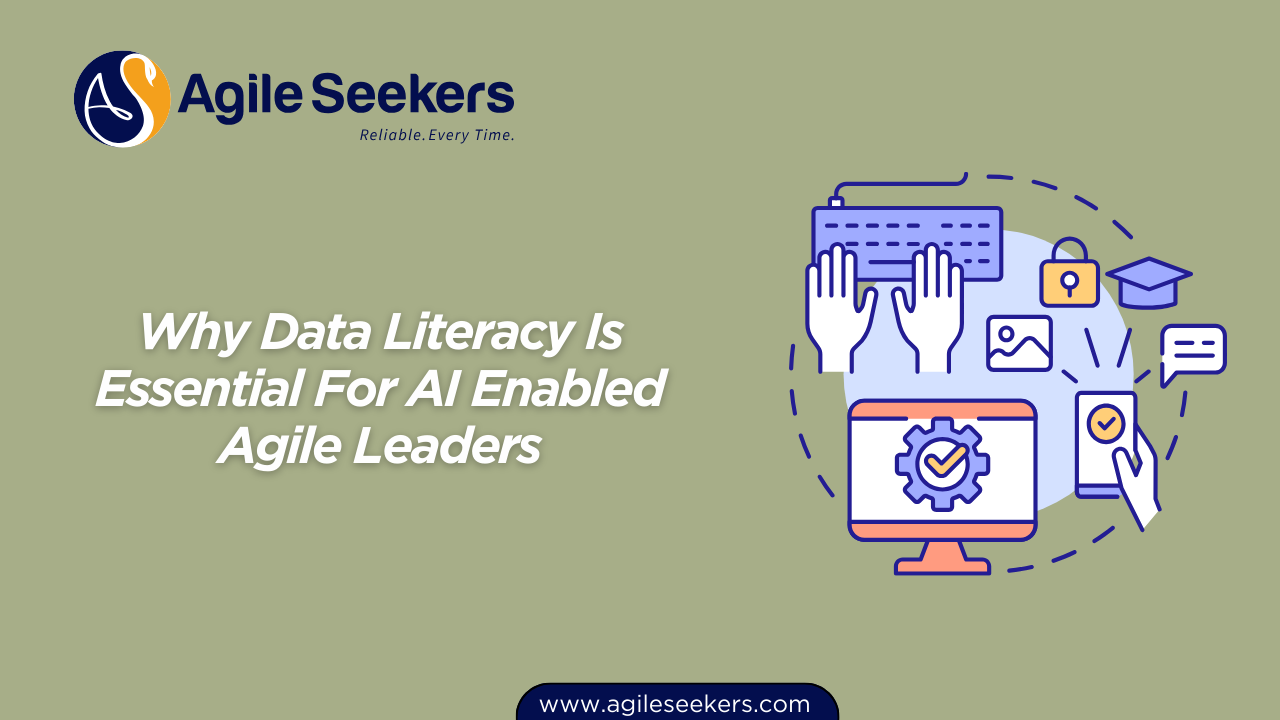Why Data Literacy Is Essential For AI Enabled Agile Leaders

Agile leaders are no longer just facilitators of processes and culture. The rise of AI in product development, decision-making, and strategy means they must also be fluent in interpreting, questioning, and acting on data. This isn’t about becoming a data scientist—it’s about gaining data literacy: the ability to understand data sources, spot patterns, ask the right questions, and use insights to guide teams.
Without strong data literacy, AI-enabled decision-making risks becoming a black box—leaders nod at recommendations without truly understanding them. That’s dangerous for both agility and innovation.
1. What Data Literacy Means for Agile Leaders
Data literacy goes beyond knowing how to read a chart. For an AI-enabled Agile leader, it involves:
-
Understanding where the data comes from – knowing the source, how it was collected, and its reliability.
-
Interpreting AI-generated insights – assessing whether an AI model’s recommendations align with business and customer goals.
-
Recognizing bias and limitations – identifying where data may be incomplete, outdated, or skewed.
-
Communicating insights clearly – translating complex findings into actionable direction for teams and stakeholders.
When leaders develop this skillset, they can bridge the gap between AI capabilities and Agile values like transparency, adaptability, and customer focus.
2. Why AI Makes Data Literacy Non-Negotiable
AI thrives on data. The quality of its outputs depends entirely on the quality and context of its inputs. Agile leaders relying on AI for backlog prioritization, sprint forecasting, or customer feedback analysis must be able to:
-
Evaluate AI outputs with a critical lens
An algorithm might suggest accelerating feature X over feature Y, but leaders must understand the data behind that suggestion before making a decision. -
Spot anomalies before they derail outcomes
For example, a sudden drop in customer engagement might appear in AI dashboards. Without data literacy, a leader may misinterpret it as a seasonal dip rather than a sign of a usability issue. -
Ask better questions of both AI tools and team members
Data-literate leaders don’t just ask, “What does the report say?” They ask, “What assumptions went into this? What’s missing? What happens if we test an alternative hypothesis?”
3. The Agile-AI Synergy
AI can enhance Agile practices, but only if leaders ensure it supports rather than replaces human judgment. Here’s how data literacy plays into core Agile activities:
-
Backlog Prioritization – AI can score backlog items based on customer value, effort, and predicted ROI. A data-literate leader validates those rankings and adjusts for context the model can’t see.
-
Sprint Planning – Predictive analytics can forecast team velocity. Leaders with data literacy skills can determine whether to trust the forecast or adjust based on qualitative insights.
-
Retrospectives – AI sentiment analysis on team feedback can surface hidden frustrations, but a leader must interpret tone, cultural nuances, and non-verbal cues.
For leaders who want to deepen this capability, the AI for Agile Leaders and Change Agents Certification offers structured learning on integrating AI tools while maintaining Agile integrity.
4. The Risks of Poor Data Literacy
Ignoring data literacy in an AI-enabled Agile environment creates several risks:
-
Blind Trust in AI – Accepting AI recommendations without validation can lead to misguided priorities.
-
Misinterpretation of Metrics – Confusing correlation with causation can cause poor strategic choices.
-
Overlooking Bias – Failing to spot skewed training data can perpetuate systemic problems.
-
Erosion of Team Trust – If leaders can’t explain why AI outputs influence decisions, teams may lose confidence in leadership.
These risks compound over time, turning AI from a productivity booster into a liability.
5. Building Data Literacy as an Agile Leader
a) Start with the basics
Learn to read and question dashboards, KPIs, and visualizations. Understand the difference between quantitative and qualitative data—and when each matters.
b) Learn the language of AI
You don’t need to code, but you should understand concepts like model accuracy, training data, confidence intervals, and overfitting. This makes conversations with data teams more effective.
c) Challenge the numbers
When reviewing AI recommendations, ask:
-
What data was used?
-
Is it current?
-
What variables are missing?
-
How sensitive are the results to outliers?
d) Integrate qualitative checks
Pair AI insights with customer interviews, user testing, and direct observation. Data literacy includes knowing when not to rely solely on metrics.
6. Embedding Data Literacy in Agile Leadership Culture
Leaders can strengthen their entire organization’s agility by making data literacy a shared value:
-
Data-driven retrospectives – Review AI and analytics insights alongside team observations.
-
Transparent decision logs – Document how data informed each decision and where human judgment overruled AI.
-
Continuous learning loops – Encourage teams to experiment, measure, and refine based on both AI and human feedback.
External research, like the Data Literacy Project, offers useful frameworks and case studies that can inspire leaders to build this into their culture.
7. The Competitive Advantage
Organizations that combine AI with strong data literacy in leadership will:
-
Respond to market changes faster.
-
Align product decisions with real customer needs.
-
Reduce costly missteps from misinterpreted data.
-
Create trust in AI-assisted processes.
For Agile leaders, this means moving beyond “managing work” to “guiding intelligent, data-driven adaptation.”
Final Thoughts
AI is a powerful ally for Agile leaders—but only if they can interpret, question, and communicate the insights it delivers. Data literacy isn’t a side skill anymore. It’s core to leading effectively in a digital, AI-enabled environment.
Leaders who invest in this capability will be the ones who harness AI to amplify, not replace, human judgment—and that’s where real business agility lives.
Also read - Integrating AI Insights Into Portfolio And Program Management
Also see - Using AI To Drive Continuous Improvement Across Agile Teams




















